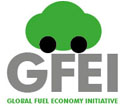
Technology mandates
In addition to using taxation schemes, import restrictions, and standards to spur innovation and improve fleet performance, some countries may decide to put in place policies and incentives geared toward encouraging a particular type of more efficient vehicle or fuel.
While most automotive fuel efficiency policies are technology-neutral, there are some examples of where technology mandates have been used.
United States
In 1990 the California Air Resources Board (CARB) passed the zero-emissions vehicle (ZEV) mandate, which was later revised. The 2009 CARB guideline required that auto makers build a total of 7,500 electric and hydrogen fuel cell cars between 2012 and 2014. The new rules also require the auto industry to produce nearly 60,000 plug-in hybrids in that time frame. The mandate’s complex system of credits apply to Ford, General Motors, Toyota, Chrysler, Honda and Nissan Motor Co. Smaller car companies might be bound by these rules if sales increase.
There are no technology mandates per se in the U.S. at the federal level. The standards in place now are performance-based standards. However, when the catalytic converter technology was developed in the early 1970s, the US EPA set emission standards that required the use of catalysts to meet the standards set. This is an example of standards that push innovation for lower emissions. As a case in point, the 2010 US fuel economy rules will require auto makers to move toward a U.S. fleet average fuel economy of 34.1 mpg (6.9 L/100 km) by 2016. Each year, fleet fuel economy will average an increase of 4%, beginning in 2011 with 2012 model-year vehicles. This will translate into around $52 billion in investments in new technology, namely for Ford Motor Co., General Motors Co. and Chrysler Group LLC.
Due to these requirements and investment, the U.S. fleet should have an average fuel economy of 29.7 mpg (7.9 L/100 km) in model-year 2012, and improvement from 27.3 mpg (8.6 l/100 km) in 2011, with CO2 levels expected to decline to an average of 250 g/mile by 2016, from 305 g/mile today.
European Union
While there is no technology mandate in the EU, because of the heavy reliance on diesel European manufacturers have developed technology to reduce emissions and improve the fuel efficiency of the diesel engine.
Denmark
As of 2008, 35 million Danish kroner ($5.7 million) has been allocated to research and development of electric vehicles over 5 years. Along with this, the Climate and Energy Ministry is considering the merits of different charging systems, infrastructure and battery types, the legal status of electric and hybrid vehicles, and the freedom of motorists to choose among electricity suppliers.
A report released by the Climate and Energy Ministry indicates that even though the technology of electric vehicles is improving, the success of this technology depends on an intelligent electricity grid that will recharge batteries when demand for energy is low and will take power from charged batteries when energy demand is high.







